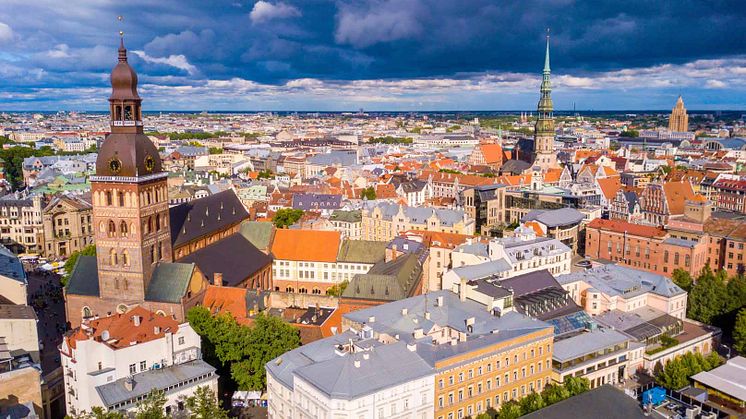
Press release -
Head east for the biggest city break bargains in Europe
10 best value cities: Riga, Vilnius, Warsaw, Podgorica, Lisbon, Lille, Gdansk, Krakow, Porto and Zagreb
- Riga rates as best value in the annual City Costs Barometer of 38 European cities, with fellow Baltic States capital, Vilnius, in the runner-up position
- New additions to the survey Podgorica and Gdansk are among seven Eastern European cities that dominate the best value top 10 (www.postoffice.co.uk/citycosts)
- Portugal offers British visitors the lowest city break prices in Western Europe: Lisbon and Porto both feature in the Post Office top 10
- Despite the volatile pound, prices have fallen year-on-year in half of the cities surveyed
The Latvian capital Riga has regained its position as Europe’s best value city for a short break for the first time in over a decade, according to the annual Post Office Travel Money City Costs Barometer, this year featuring 38 cities. The barometer found that prices have fallen in half of the cities surveyed and Eastern European cities again dominate the best value top 10, taking seven of the leading 10 places. These include two new additions to the survey, Gdansk and Podgorica – Montenegro’s capital. Low prices in Lisbon and Porto make Portugal best value for a city break in Western Europe.
At £253 for 12 tourist items including accommodation, meals and drinks, city transport and entry to cultural attractions, Riga has risen from sixth place last year to top the chart for the first time since 20121. This is because prices in Riga are down 15 per cent year-on-year compared with those in runner-up city, Vilnius, where the barometer total rose 7.5 per cent to £254. The rising cost of accommodation in the Lithuanian capital is the key factor. Prices in the two Baltic states are around 60 per cent lower than in Oslo (£636) and Copenhagen (£629), the most expensive cities surveyed.
Poland boasts three cities in this year’s city breaks top 10. Warsaw (£277) has moved up from 10thto third place with a price fall of 13.2 per cent, mainly as a result of a £39 fall in accommodation costs (£131 for two nights compared with £170 a year ago). Krakow (£300) again makes the top 10 but has dropped from fourth to eighth place because of a 7.7 per cent price increase. One place higher in seventh position Gdansk, surveyed for the first time this year, costs £297 for the barometer items.
Also new for 2025, Podgorica in the emerging tourist destination of Montenegro has shot into the top 10 in fourth place. Its overall cost of £282 is 29 per cent lower than Dubrovnik in neighbouring Croatia (18th, prices down one per cent), where the barometer total of £396 is £114 pricier.
Portugal’s Algarve topped the recent Worldwide Holiday Costs Barometer chart of global destinations published in the 2025 Holiday Money Report and its two major cities now feature in the City Costs Barometer top 10, illustrating the good value available to British holidaymakers. Although prices are up 10.8 per cent in Lisbon (5th, £292), the Portuguese capital remains the highest placed Western European city. Porto (9th, £305) has moved back into the leading 10 cities from 13th place last year after registering an overall price fall of 15.5 per cent, thanks to better hotel availability.
Rising from 11th last year to 10th position in the new survey, Zagreb (£311) is the fourth new entrant to the best value top 10, gaining its place because of a 4.4 per cent fall in barometer prices. Lille (6th, £293) completes the top 10 line-up. The four new top 10 cities replace Bratislava (11th, £314), Prague (12th, £330), Athens (13th, £332) and Budapest (15th, £342).
Post Office researchers found that costs for tourist items have fallen in half of cities (18 of the 36 also surveyed a year ago), despite recent volatility for sterling2. The biggest drop has been in Helsinki, the lowest priced Scandinavian city in this year’s barometer. At £468, prices have plummeted by over 20 per cent to take the Finnish capital to 21st place from 34th last year. Conversely, barometer prices have risen significantly in Berlin, where a 20 per cent increase in tourist costs has seen the city fall from 21stto 34th place with a barometer total of £588.
Accommodation costs account for the more dramatic movements since last year3. A scarcity of three-star tourist accommodation means that the cost of a two-night hotel stay has risen by as much as 24 per cent in Athens. More positively, Post Office Travel Money also found evidence that better availability had resulted in lower prices in 20 cities. A good example is Amsterdam, where accommodation has been very expensive in recent years. The latest survey found that prices have fallen by 19.5 per cent since last year and by 29 per cent compared with 2023. Other big accommodation falls were reported in Porto and Warsaw (-23 per cent), Vienna (-22 per cent), Paris and Riga (-21 per cent) and Helsinki (-39 per cent).
Laura Plunkett, Head of Travel Money at Post Office, the UK’s largest provider of foreign currency, said: “Although city break holidaymakers need to keep a watchful eye on exchange rates, the real challenge will be the cost of accommodation in the cities Britons are considering. Successive City Costs Barometers have found big swings in hotel costs depending on how many rooms are available in peak months. This year is no different and rising – or falling – hotel prices can have a big impact on city break costs.
“For example, Vilnius lost its top spot in the latest chart because the cost of accommodation has risen by over nine per cent since last year, while it has fallen over 20 per cent in Riga in the same period. When the cost of two nights’ accommodation is excluded, Vilnius remains cheaper for British visitors at around £111 compared with nearly £130 in Riga.”
After accommodation, eating out is the biggest cost that British tourists are likely to face and here too Post Office Travel Money found wide variations in the price of a three-course meal for two across the 38 cities4. These varied from as little as £47 in Lisbon and £56 in Porto to over £172 in Oslo, £155 in Geneva and £154 in Copenhagen.
Closer to home, Cardiff (17th, £375) rates as cheapest of the three British capitals surveyed, following an 8.3 per cent drop in barometer costs. Prices also fell marginally – by 0.1 per cent - in both London (26th, £523) and Edinburgh (36th, £602) but they are significantly more expensive cities to visit than Cardiff. Additionally, cultural sightseeing remains one of the most popular ingredients of a city break and Cardiff scores well because it offers free entry to its top museum, art gallery and heritage site.
Dublin (31st, £568) also emerges from this year’s survey as a city where cultural attractions come with a low price tag. This is because entry to its leading museum and gallery are free, while the charge for its top heritage attraction, Kilmainham Gaol, is only £7.01. By comparison, entry to Florence’s star cultural attractions costs almost nine times as much - £62.19.
The Post Office is the UK’s leading foreign currency provider, offering over 60 currencies for pre-order at around 7,000 Post Office branches or online at www.postoffice.co.uk/travel-money for next day branch or home delivery. 3,600 larger Post Office branches stock the leading currencies and over 7,000 offer euros over the counter without pre-order. These can also be ordered online for same day ‘click and collect’ at selected branches, next day collection at any branch or home delivery.
Ends
The full results of the 2025 Post Office Travel Money City Costs Barometer can be found in the attached tables or viewed online at: postoffice.co.uk/citycosts.
Categories
About the Post Office
- With over 11,500 branches, Post Office has the biggest retail network in the UK, with more branches than all the banks and building societies combined.
- Post Office is helping anyone who wants cash to get it whichever way is most convenient. Partnership with over 30 banks, building societies and credit unions means that 99% of UK bank customers can access their accounts at their Post Office.
- Cash withdrawals, deposits and balance enquiries can be made securely and conveniently over the counter at any Post Office; and the biggest investment by any organisation or company in the last decade is being made to safeguard 1,400 free-to-use ATMs across the UK.
- Post Office is simplifying its proposition for Postmasters with a focus on its cash and banking; mails and parcels; foreign exchange; and; bill payments services.
- Research has found that visits to the Post Office help drive another 400 million visitors to other shops, restaurants and local businesses equating to an estimated £1.1 billion in additional revenue for High Street businesses.
- 99.7% of the population live within three miles of a Post Office; and 4,000 branches are open seven days a week.





